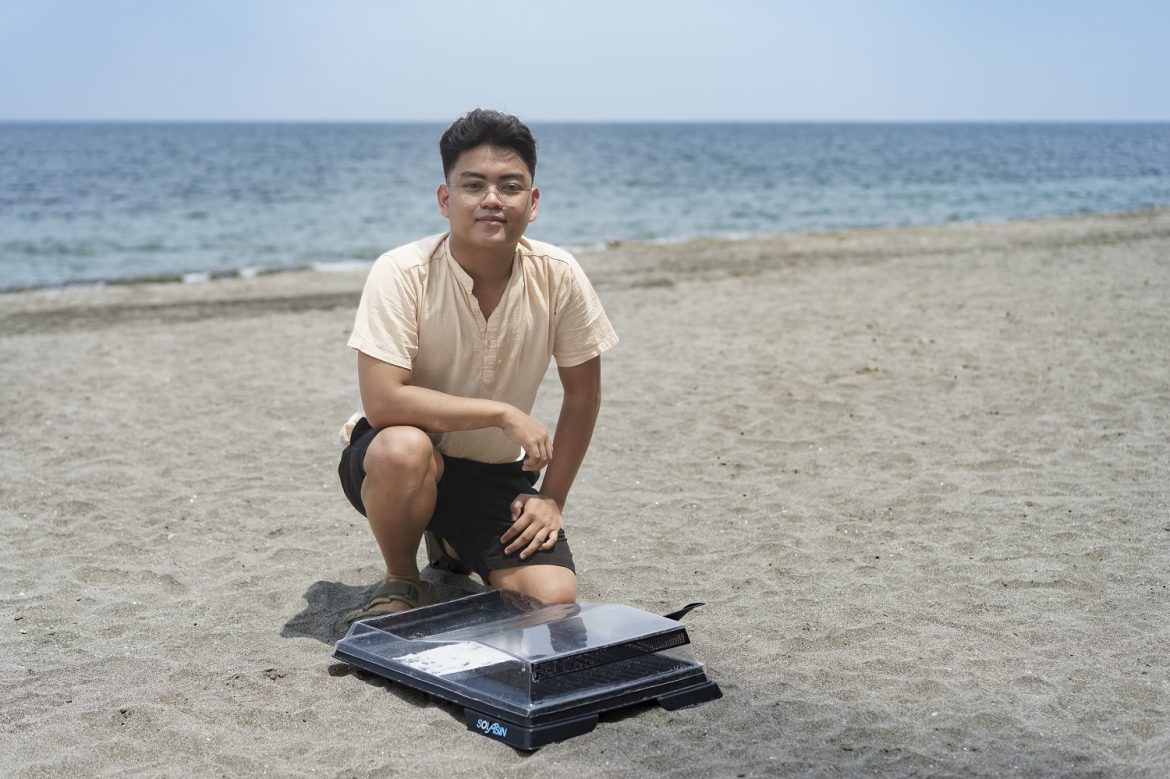This year’s Philippine national winner of the James Dyson Award tackles the lack of sustainable and viable livelihood options in coastal communities in the Philippines. Despite the passage of the Salt Industry Development Law, the country imports 93% of its salt needs, a stark sign of how the once-thriving local salt industry has deteriorated.
The decline of local salt production has been driven by multiple factors: climate change, limited technological advancements, lack of consistent government support, urbanization and reclamation of bay areas, and even the construction of coastal roads—all of which disrupted traditional salt beds. Over time, these pressures, coupled with waning interest in salt farming among younger generations, have left coastal communities struggling to sustain what was once a vital source of livelihood.
SolAsin introduces an accessible, solar-based method for producing high-value flaky salt using seawater and sunlight, revitalizing local industries and reducing dependence on imports.
The Invention
Inspired by his hometown of Pangasinan, which directly translates to ‘a place where salt is made,’ John Carlo Luna Reyes, an industrial design student from UP Diliman, developed SolAsin to help coastal communities revive a livelihood once central to their identity.
John shares: “Growing up in Pangasinan, I saw firsthand how coastal communities struggled to access sustainable livelihood opportunities. As a designer and an Iskolar ng Bayan, I have always felt a responsibility to use my skills to empower my own community.”
Unlike traditional salt beds that demand vast land and capital, SolAsin is compact, sustainable, and easy to use. It only requires filtered seawater, sunlight, and occasional remixing to produce premium flaky salt—a variant with high market value in small quantities that can be sold to nearby food establishments, hotels, and even tourists, creating new livelihood opportunities.
Reyes developed and tested SolAsin in close consultation with coastal residents, local government, and the provincial environmental office. He refined the design through multiple prototypes and months of fieldwork, gathering feedback that confirmed its usability and income-generating potential.
SolAsin takes home ₱361,300 from the James Dyson Award national prize, which he plans to use to continue developing the design, improve materials, and prepare for mass production.
Dr. Jaine Cadoc-Reyes, James Dyson Award Philippines national judge and a Professor from the University of the Philippines Los Baños, says: “SolAsin stood out for its simplicity, scalability, and social impact. It’s a brilliant example of how design can empower communities and revive local industries.”
Melvin John Dela Peña, James Dyson Award Philippines National Judge and Senior Programme Manager at Dyson adds: “This invention exemplifies Dyson’s engineering ethos—problem-solving through iterative design. SolAsin’s thoughtful integration of local resources and community feedback makes it a standout solution.”
“This recognition is more than just a personal achievement—it is a win for the communities that inspired SolAsin. My goal has always been to design with and for the people, and this award gives me the opportunity to further develop the project so it can truly uplift local salt farmers. I hope this inspires more young Filipino designers to look to our own communities and industries for solutions that can create lasting change,” said Reyes.
The Runners Up
Problem: Amid the soaring heat indices, many Filipino homes and schools lack air-conditioning because of steep upfront costs and high energy use, impairing comfort, focus and well-being.
Solution: ChillWise is a passive, energy-efficient cooling panel system that can reduce energy use by up to 95% compared to conventional concrete. It combines lightweight foamed concrete with special heat-storing materials, along with agro-waste such as rice hull ash and fly ash, to passively regulate indoor temperatures and save on cooling cost. As it absorbs heat during the day and releases it at night, ChillWise moderates indoor temperatures naturally without electricity, while promoting circular design.
Problem: The Philippines grapples with deforestation and heavy reliance on imported wood. Meanwhile, native resources like bamboo and cattail grass (Lampakanay) remain abundant yet underutilized.
Solution: Lambooply is a durable, eco-friendly composite material made by reinforcing bamboo with Lampakanay fibers. Using non-toxic adhesives, this material delivers strength, stability, and aesthetic appeal—without relying on slow-growing trees and synthetic materials—for both structural and non-structural applications.
SolAsin, along with ChillWise and Lambooply, will progress to the next stage of the James Dyson Award, with the international Top 20 shortlist to be announced on October 15, selected by a global team of Dyson engineers, and the global winners on November 5, chosen by James Dyson.
James Dyson Award
The James Dyson Award is an international design competition that inspires and celebrates the next generation of design engineers. Now in its 20th year, it continues its legacy of empowering design and engineering students to solve real-world problems through technology and design, inspiring the next generation of innovators to transform ideas into impactful solutions. As of today, the Award has supported more than 400 problem-solving inventions with over ₱70 million in prize money. It operates across 28 countries and regions and is run by the James Dyson Foundation, Sir James Dyson’s engineering-education charity.



